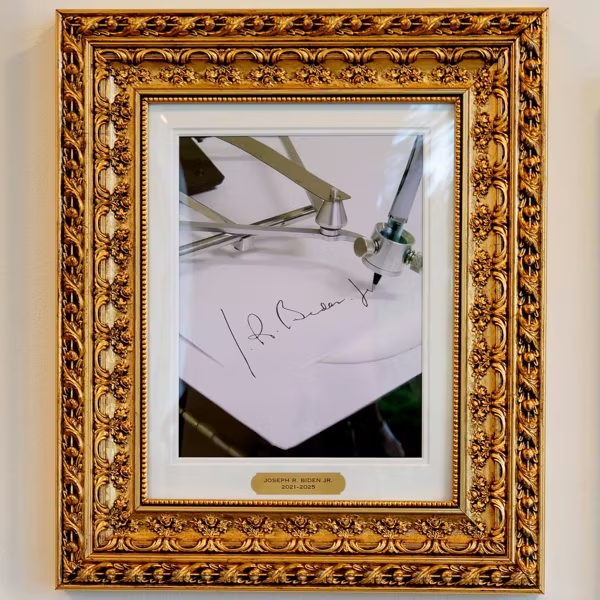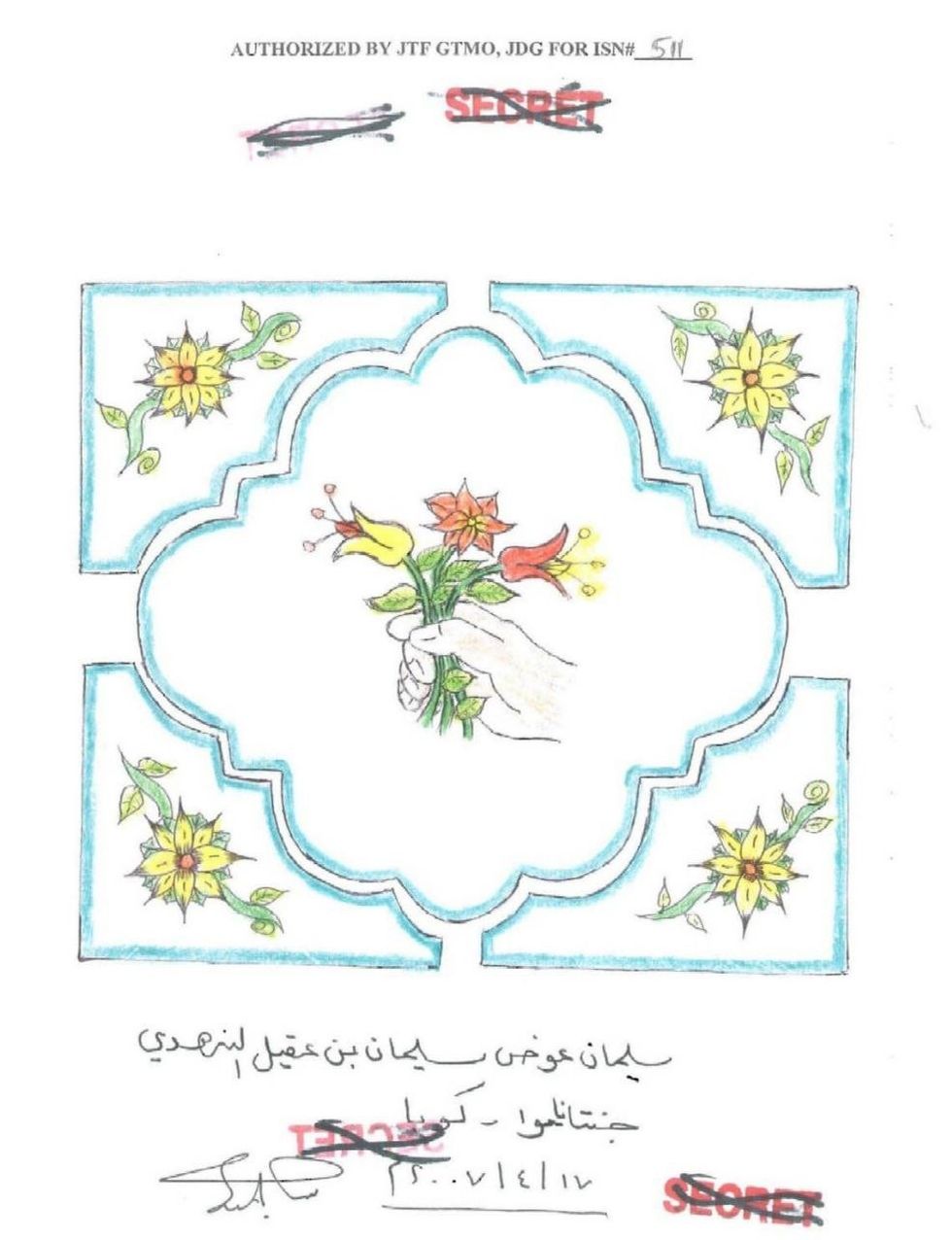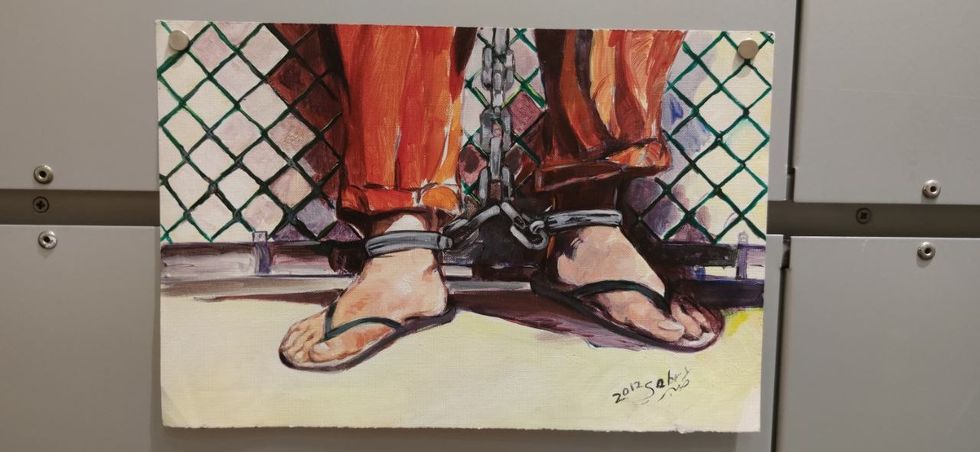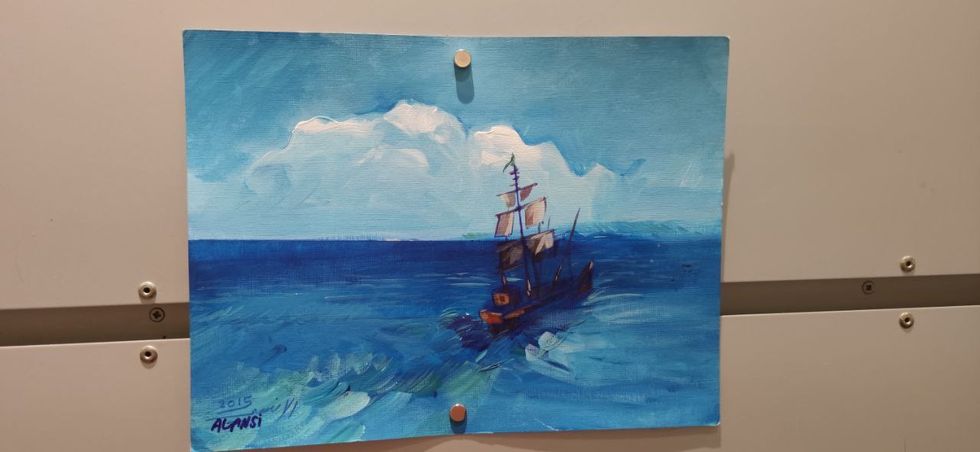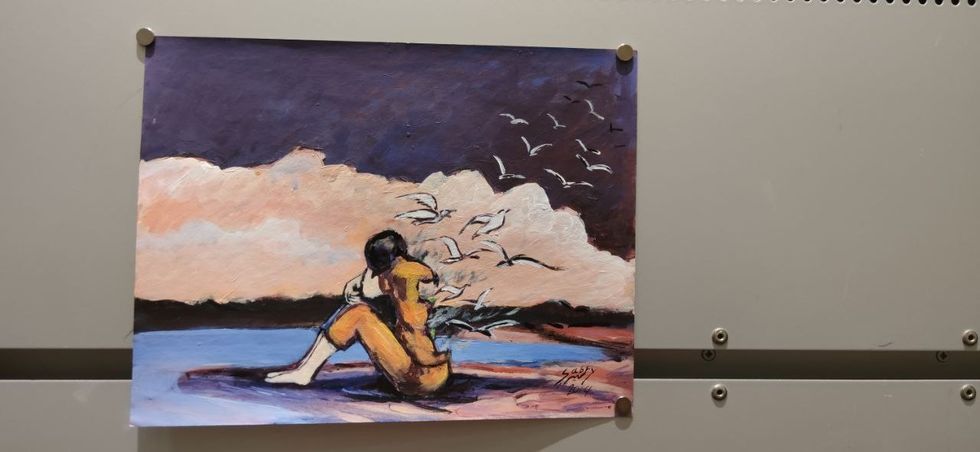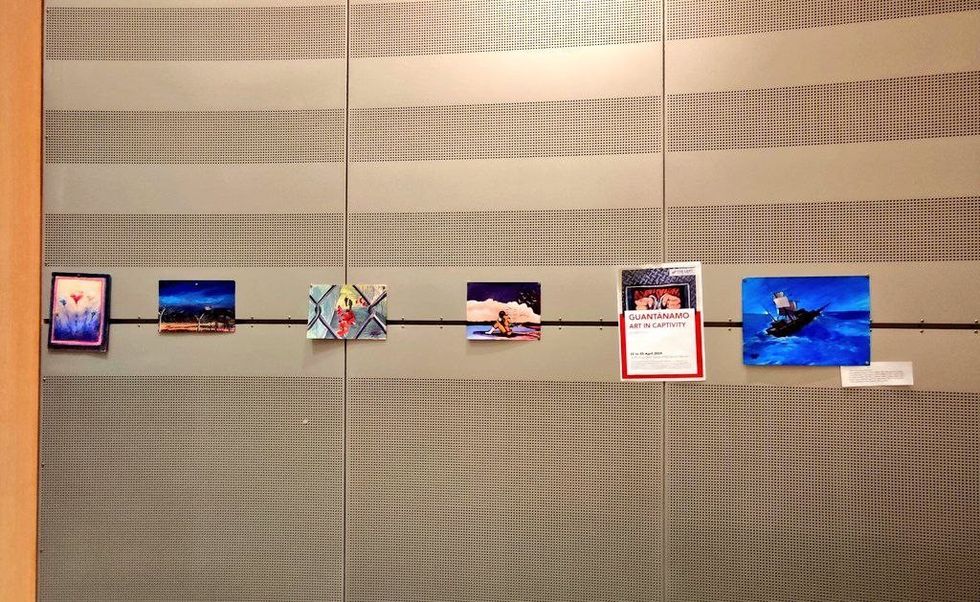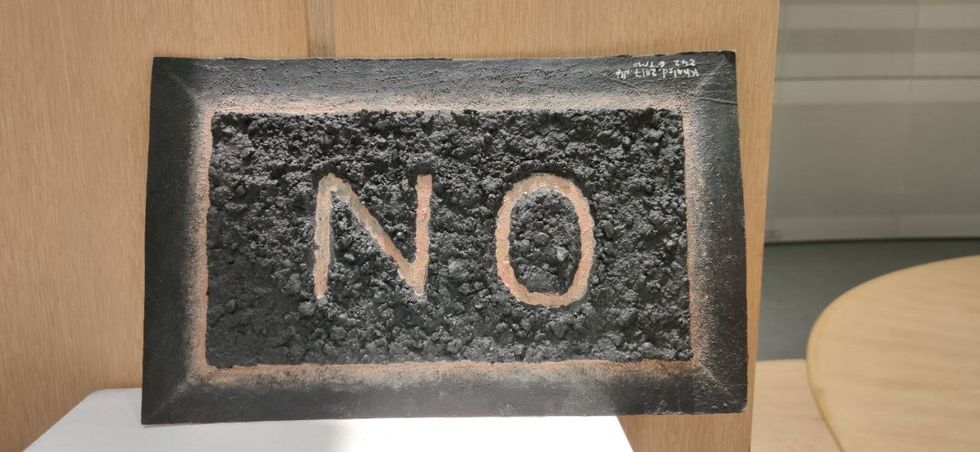
Mansoor Adayfi attends the "Guantánamo: Art in Captivity" exhibit at the European Parliament.
Art From Guantánamo Shatters the Silence in the Halls of Power
An evocative exhibition at the E.U. parliament, which ran from April 2 to 5, transcended the physical confines of the military prison, offering a poignant glimpse into the lives of those ensnared within its walls.
From the distant shores of Guantánamo Bay to the heart of the European Parliament in Brussels, a powerful exhibition titled "Guantánamo: Art in Captivity" emerges, shattering the silence that has long shrouded the infamous U.S. military prison. The exhibit, which relayed poignant stories from the men detained, demonstrated the power of art to bring to life the haunting images of the pain and suffering they endured.
Attending and presenting at the exhibit, I embraced my identity as detainee 441—a prisoner classified as the worst of the worst, but who, nevertheless and against all odds, was welcomed in the European Union parliament for the second time to tell a different story of Guantánamo—the men's stories. Our story.
Guantánamo is present for the second time at the E.U. parliament; the first time was last year where two Irish Members of European Parliament (MEPs) Clare Daly and Mick Wallace hosted a special conference about Guantánamo. The gathering's importance cannot be overstated, and it was described as the "most significant gathering on Guantánamo," it underscored the gravity of the ongoing human rights struggle. It provided a platform for former prisoners, 9/11 family victims, former camp staff, the former United Nations special rapporteur to Guantánamo, lawyers, activists, and advocates to raise their voices against atrocities committed in the name of justice.
Even when we were isolated from the rest of the world and had nothing in our cages, using apple stems as pencils and Styrofoam cups and clamshells as our paper, we drew flowers.
At its core were firsthand accounts of Guantánamo's horrors. Former prisoners and military personnel, including ex-Army captain and Muslim chaplain James Yee, shared tales of detention, torture, and resilience. Their stories reminded us of the human toll of indefinite detention and the urgent need for justice and accountability.
In the European Parliament, a resounding message echoed: We won't rest until Guantánamo is closed and every individual's rights are honored. This wasn't just a gathering; it symbolized the enduring human spirit's commitment to justice. May its impact inspire future generations to fight for what's right and just.
As voices filled the chamber, a collective call to action emerged. Attendees were urged to confront Guantánamo's reality and demand accountability for its crimes. Through powerful testimonies, they highlighted the plight of detainees and the need to hold perpetrators accountable.
The "Close Guantánamo!" event was a rallying cry for those who believe in every human being's dignity and worth. It reminded us that silence equals complicity and urged us to continue demanding justice until Guantánamo is closed and justice prevails for all.
Art was always present at Guantánamo, even in the opening days of 2002 when the U.S. government sent its first prisoners to Camp X-Ray. Even when we were isolated from the rest of the world and had nothing in our cages, using apple stems as pencils and Styrofoam cups and clamshells as our paper, we drew flowers. Later, we used toilet paper, powdered tea, and soap to draw and write poetry.
Of course, any form of artistic expression, particularly when we organically found ways to create beauty out of the ugliness of the prison, was always against the camp rules. Camp administrators, guards, and interrogators routinely confiscated our work and punished us. They punished us for singing and dancing, too. They feared that the we, the monsters they constructed us to be, were sending each other secret messages, instead of finding ways to cope with the brutality of detention and torture. Artistic expression made us feel human in a place that was designed to strip us of our dignity.
Before 2010, it was customary for art to be integrated into interrogation sessions within the chambers. Artwork produced during these sessions was routinely confiscated, repurposed as evidence, and classified accordingly. An illustrative example is a painting by Suliman, created during an interrogation session in 2007, serving as proof to interrogators of his artistic abilities. The painting bore multiple red stamps denoting its classification as "SECRET." Suliman inscribed his full name, the date, and signed it in Arabic.
In 2010, after former U.S. President Barack Obama ordered a complete review of Guantánamo, living conditions improved. For the first time since opening, we were allowed to attend art classes. Of course, we weren't free by any means and in order for us to attend these classes, we had to endure humiliating searches, and thereafter we were shackled and chained to desks and chairs while in the classroom. Even though we only had a few minutes in class and the supplies were limited, these classes provided us with a place where we could express ourselves outside the confines of a system that criminalized us and treated us as irredeemable.
We could draw and paint the world outside we missed most—the beautiful blue sky, the sea, flowers, and nature. We painted our pain, our fear, our hope, our dreams. After eight years of indefinite and arbitrary detention, we felt connected again to our lost humanity. Each brushstroke colored in a piece of who we once were.
During the Obama administration, we were allowed to send our artwork to our lawyers and families. The journey of artwork out of Guantánamo was similar to ours, and it was not spared from the violence that is Guantánamo.
Each painting we created had to go through a rigorous process of review and censorship by multiple agencies and departments in order to leave the prison. Some of our artwork disappeared, some was redacted and silenced, and some made it out of the military prison. Was that ship a message? Was the art communicating an imminent threat? Anything suspicious lead to immediate disappearance (a death sentence). If artworks survived the scrutiny of the censors, they were registered, numbered, and stamped. But that didn't mean the artwork wouldn't be confiscated or taken later. Suffice it to say that the stamp on the back of the art continues to be reminder of the violence we endured, and which many still endure, at Guantánamo .
Moreover, like Guantánamo prisoners, some art died at Guantánamo. Some art is still held there waiting to be released.
At one point, even the U.S. government created an art gallery at the camp to exhibit our artwork for visitors and the media. While art helped to make us human again, the camp administration used what we created to construct the illusion that we were treated humanely.
I was one of the prisoners who made it out of Guantánamo—more fortunate than many who continue to languish behind bars. My journey to this point—standing in front of the E.U. parliament as a free man without shackles, chains, and no guards dragging me around for sport—was long and arduous. While I stood in my orange shirt looking at each painting for the first time after I was released in 2016, the memories of the place that tortured and detained me flashed through my mind, tears blurring my vision as I reconnected with my paintings. It was not just feelings of anguish however that filled my memories, but resilience as well—the resilience that I knew then would get me here now.
"It's nice to see you again my sweethearts. I'm glad we made it in one piece. I've missed you."
These are all things I said to my paintings, which could never be reduced to a piece of paper, but are testaments to our struggle for survival amid unimaginable cruelty.
This evocative exhibition, which ran from April 2 to 5, transcended the physical confines of the military prison, offering a poignant glimpse into the lives of those ensnared within its walls. Each stroke of the brush is a testament to the artists' resilience, a silent plea for justice. Each painting is proof of survival, while also being an act of resistance. We entrusted our secrets, tears, and hope to art from Guantánamo.
While the U.S. government suppressed our voices by banning and threatening to burn our artwork in 2017, courageous MEPs like Stelios Kouloglou, Daly, Wallace have breathed life into our creations, challenging these oppressive measures and amplifying our cries for justice. It's my honor to curate this exhibition. "Art from Guantánamo" marks a historic moment—a beacon of hope illuminating the darkness of secrecy and isolation.
The artwork on display varies from poignant portraits that capture the depth of human experience to haunting landscapes that echo the desolation of confinement. Each piece narrates a story of shattered dreams, stifled aspirations, and voices yearning to be heard.
These creations narrate stories of dreams that were imprisoned and aspirations stifled. They serve as a stark reminder of the human cost of policies shrouded in secrecy, urging us to confront uncomfortable truths and demand accountability.
As visitors navigated the exhibition, they were confronted with uncomfortable truths—the human consequences of policies enacted in the name of national security. The art became a call to action, urging a demand for accountability and the upholding of fundamental principles of human rights.
Among the collective voices, four names resonate with enduring resilience—Khalid Qassim, Moath Al-Alwi ,Tawfiq Al-Bihani, and Ammar al-Baluchi. These artists, imprisoned in Guantánamo for over two decades despite three of them have been cleared for release, continue to defy injustice through their art, their spirits unbroken by the passage of time. Their art, bleeding from behind bars, epitomizes the unwavering spirit of resilience in the face of injustice.
Among the attendees of the exhibition were Guantánamo lawyers Alka Pradhan and Navy Lieutenant Jennifer Joseph, who represent several of the prisoners. During a panel discussion, Pradhan shed light on the legal complexities surrounding Guantánamo, remarking, "It is deeply moving to witness the resilience and humanity of men who have endured unimaginable suffering. This exhibition serves as a poignant reminder of the ongoing crisis at Guantánamo and underscores the urgent need for global unity to put an end to this atrocity."
The impact of "Art from Guantánamo" transcended the walls of the exhibition space. It served as a call to carry these stories forward, to advocate for justice and freedom beyond. Let us amplify the voices of those who seek justice and speak of resilience despite their confinement. May this exhibition ignite conversations that spark action—a collective demand for the closure of Guantánamo and a renewed commitment to accountability.
This is a unique opportunity to witness firsthand the enduring human spirit in the face of unimaginable hardship. Together, let us ensure that these stories are heard and that the fight for justice continues.
Today, 30 individuals remain imprisoned in Guantánamo, 16 of whom have been cleared for release. However, despite efforts to address the situation, reports of abuse in the prison persist. Last month, detainees in Guantánamo went on a hunger strike to protest the mistreatment and abuse they endure, yet the U.S. government continues to suppress such reports, denying journalists access to the prison for accurate reporting.
During her visit to Guantánamo last year, the former U.N. Special Rapporteur Fionnuala Ní Aoláin expressed significant concerns regarding the treatment of prisoners. Her report highlights alarming issues such as the ongoing detention of individuals without trial, limited access to healthcare, and the potential use of torture methods, including prolonged periods of solitary confinement. Additionally, she emphasized the absence of proper legal procedures, drawing attention to the prolonged imprisonment of individuals without formal trials.
Guantánamo symbolizes injustice, torture, and abuse of power. It is where humanity and beauty are sentenced to death. However, the “Art from Guantánamo" exhibit in the European Parliament conveys a different message—one of survival. This is why we must heed the call to action for justice and accountability that is deeply embedded in each of the paintings. Now that many of us have borne witness to the men's powerful stories, we must ensure that they are never again silenced and in doing so, commit ourselves to the pursuit of justice, dignity, and freedom for all.
An Urgent Message From Our Co-Founder
Dear Common Dreams reader, The U.S. is on a fast track to authoritarianism like nothing I've ever seen. Meanwhile, corporate news outlets are utterly capitulating to Trump, twisting their coverage to avoid drawing his ire while lining up to stuff cash in his pockets. That's why I believe that Common Dreams is doing the best and most consequential reporting that we've ever done. Our small but mighty team is a progressive reporting powerhouse, covering the news every day that the corporate media never will. Our mission has always been simple: To inform. To inspire. And to ignite change for the common good. Now here's the key piece that I want all our readers to understand: None of this would be possible without your financial support. That's not just some fundraising cliche. It's the absolute and literal truth. We don't accept corporate advertising and never will. We don't have a paywall because we don't think people should be blocked from critical news based on their ability to pay. Everything we do is funded by the donations of readers like you. Will you donate now to help power the nonprofit, independent reporting of Common Dreams? Thank you for being a vital member of our community. Together, we can keep independent journalism alive when it’s needed most. - Craig Brown, Co-founder |
From the distant shores of Guantánamo Bay to the heart of the European Parliament in Brussels, a powerful exhibition titled "Guantánamo: Art in Captivity" emerges, shattering the silence that has long shrouded the infamous U.S. military prison. The exhibit, which relayed poignant stories from the men detained, demonstrated the power of art to bring to life the haunting images of the pain and suffering they endured.
Attending and presenting at the exhibit, I embraced my identity as detainee 441—a prisoner classified as the worst of the worst, but who, nevertheless and against all odds, was welcomed in the European Union parliament for the second time to tell a different story of Guantánamo—the men's stories. Our story.
Guantánamo is present for the second time at the E.U. parliament; the first time was last year where two Irish Members of European Parliament (MEPs) Clare Daly and Mick Wallace hosted a special conference about Guantánamo. The gathering's importance cannot be overstated, and it was described as the "most significant gathering on Guantánamo," it underscored the gravity of the ongoing human rights struggle. It provided a platform for former prisoners, 9/11 family victims, former camp staff, the former United Nations special rapporteur to Guantánamo, lawyers, activists, and advocates to raise their voices against atrocities committed in the name of justice.
Even when we were isolated from the rest of the world and had nothing in our cages, using apple stems as pencils and Styrofoam cups and clamshells as our paper, we drew flowers.
At its core were firsthand accounts of Guantánamo's horrors. Former prisoners and military personnel, including ex-Army captain and Muslim chaplain James Yee, shared tales of detention, torture, and resilience. Their stories reminded us of the human toll of indefinite detention and the urgent need for justice and accountability.
In the European Parliament, a resounding message echoed: We won't rest until Guantánamo is closed and every individual's rights are honored. This wasn't just a gathering; it symbolized the enduring human spirit's commitment to justice. May its impact inspire future generations to fight for what's right and just.
As voices filled the chamber, a collective call to action emerged. Attendees were urged to confront Guantánamo's reality and demand accountability for its crimes. Through powerful testimonies, they highlighted the plight of detainees and the need to hold perpetrators accountable.
The "Close Guantánamo!" event was a rallying cry for those who believe in every human being's dignity and worth. It reminded us that silence equals complicity and urged us to continue demanding justice until Guantánamo is closed and justice prevails for all.
Art was always present at Guantánamo, even in the opening days of 2002 when the U.S. government sent its first prisoners to Camp X-Ray. Even when we were isolated from the rest of the world and had nothing in our cages, using apple stems as pencils and Styrofoam cups and clamshells as our paper, we drew flowers. Later, we used toilet paper, powdered tea, and soap to draw and write poetry.
Of course, any form of artistic expression, particularly when we organically found ways to create beauty out of the ugliness of the prison, was always against the camp rules. Camp administrators, guards, and interrogators routinely confiscated our work and punished us. They punished us for singing and dancing, too. They feared that the we, the monsters they constructed us to be, were sending each other secret messages, instead of finding ways to cope with the brutality of detention and torture. Artistic expression made us feel human in a place that was designed to strip us of our dignity.
Before 2010, it was customary for art to be integrated into interrogation sessions within the chambers. Artwork produced during these sessions was routinely confiscated, repurposed as evidence, and classified accordingly. An illustrative example is a painting by Suliman, created during an interrogation session in 2007, serving as proof to interrogators of his artistic abilities. The painting bore multiple red stamps denoting its classification as "SECRET." Suliman inscribed his full name, the date, and signed it in Arabic.
In 2010, after former U.S. President Barack Obama ordered a complete review of Guantánamo, living conditions improved. For the first time since opening, we were allowed to attend art classes. Of course, we weren't free by any means and in order for us to attend these classes, we had to endure humiliating searches, and thereafter we were shackled and chained to desks and chairs while in the classroom. Even though we only had a few minutes in class and the supplies were limited, these classes provided us with a place where we could express ourselves outside the confines of a system that criminalized us and treated us as irredeemable.
We could draw and paint the world outside we missed most—the beautiful blue sky, the sea, flowers, and nature. We painted our pain, our fear, our hope, our dreams. After eight years of indefinite and arbitrary detention, we felt connected again to our lost humanity. Each brushstroke colored in a piece of who we once were.
During the Obama administration, we were allowed to send our artwork to our lawyers and families. The journey of artwork out of Guantánamo was similar to ours, and it was not spared from the violence that is Guantánamo.
Each painting we created had to go through a rigorous process of review and censorship by multiple agencies and departments in order to leave the prison. Some of our artwork disappeared, some was redacted and silenced, and some made it out of the military prison. Was that ship a message? Was the art communicating an imminent threat? Anything suspicious lead to immediate disappearance (a death sentence). If artworks survived the scrutiny of the censors, they were registered, numbered, and stamped. But that didn't mean the artwork wouldn't be confiscated or taken later. Suffice it to say that the stamp on the back of the art continues to be reminder of the violence we endured, and which many still endure, at Guantánamo .
Moreover, like Guantánamo prisoners, some art died at Guantánamo. Some art is still held there waiting to be released.
At one point, even the U.S. government created an art gallery at the camp to exhibit our artwork for visitors and the media. While art helped to make us human again, the camp administration used what we created to construct the illusion that we were treated humanely.
I was one of the prisoners who made it out of Guantánamo—more fortunate than many who continue to languish behind bars. My journey to this point—standing in front of the E.U. parliament as a free man without shackles, chains, and no guards dragging me around for sport—was long and arduous. While I stood in my orange shirt looking at each painting for the first time after I was released in 2016, the memories of the place that tortured and detained me flashed through my mind, tears blurring my vision as I reconnected with my paintings. It was not just feelings of anguish however that filled my memories, but resilience as well—the resilience that I knew then would get me here now.
"It's nice to see you again my sweethearts. I'm glad we made it in one piece. I've missed you."
These are all things I said to my paintings, which could never be reduced to a piece of paper, but are testaments to our struggle for survival amid unimaginable cruelty.
This evocative exhibition, which ran from April 2 to 5, transcended the physical confines of the military prison, offering a poignant glimpse into the lives of those ensnared within its walls. Each stroke of the brush is a testament to the artists' resilience, a silent plea for justice. Each painting is proof of survival, while also being an act of resistance. We entrusted our secrets, tears, and hope to art from Guantánamo.
While the U.S. government suppressed our voices by banning and threatening to burn our artwork in 2017, courageous MEPs like Stelios Kouloglou, Daly, Wallace have breathed life into our creations, challenging these oppressive measures and amplifying our cries for justice. It's my honor to curate this exhibition. "Art from Guantánamo" marks a historic moment—a beacon of hope illuminating the darkness of secrecy and isolation.
The artwork on display varies from poignant portraits that capture the depth of human experience to haunting landscapes that echo the desolation of confinement. Each piece narrates a story of shattered dreams, stifled aspirations, and voices yearning to be heard.
These creations narrate stories of dreams that were imprisoned and aspirations stifled. They serve as a stark reminder of the human cost of policies shrouded in secrecy, urging us to confront uncomfortable truths and demand accountability.
As visitors navigated the exhibition, they were confronted with uncomfortable truths—the human consequences of policies enacted in the name of national security. The art became a call to action, urging a demand for accountability and the upholding of fundamental principles of human rights.
Among the collective voices, four names resonate with enduring resilience—Khalid Qassim, Moath Al-Alwi ,Tawfiq Al-Bihani, and Ammar al-Baluchi. These artists, imprisoned in Guantánamo for over two decades despite three of them have been cleared for release, continue to defy injustice through their art, their spirits unbroken by the passage of time. Their art, bleeding from behind bars, epitomizes the unwavering spirit of resilience in the face of injustice.
Among the attendees of the exhibition were Guantánamo lawyers Alka Pradhan and Navy Lieutenant Jennifer Joseph, who represent several of the prisoners. During a panel discussion, Pradhan shed light on the legal complexities surrounding Guantánamo, remarking, "It is deeply moving to witness the resilience and humanity of men who have endured unimaginable suffering. This exhibition serves as a poignant reminder of the ongoing crisis at Guantánamo and underscores the urgent need for global unity to put an end to this atrocity."
The impact of "Art from Guantánamo" transcended the walls of the exhibition space. It served as a call to carry these stories forward, to advocate for justice and freedom beyond. Let us amplify the voices of those who seek justice and speak of resilience despite their confinement. May this exhibition ignite conversations that spark action—a collective demand for the closure of Guantánamo and a renewed commitment to accountability.
This is a unique opportunity to witness firsthand the enduring human spirit in the face of unimaginable hardship. Together, let us ensure that these stories are heard and that the fight for justice continues.
Today, 30 individuals remain imprisoned in Guantánamo, 16 of whom have been cleared for release. However, despite efforts to address the situation, reports of abuse in the prison persist. Last month, detainees in Guantánamo went on a hunger strike to protest the mistreatment and abuse they endure, yet the U.S. government continues to suppress such reports, denying journalists access to the prison for accurate reporting.
During her visit to Guantánamo last year, the former U.N. Special Rapporteur Fionnuala Ní Aoláin expressed significant concerns regarding the treatment of prisoners. Her report highlights alarming issues such as the ongoing detention of individuals without trial, limited access to healthcare, and the potential use of torture methods, including prolonged periods of solitary confinement. Additionally, she emphasized the absence of proper legal procedures, drawing attention to the prolonged imprisonment of individuals without formal trials.
Guantánamo symbolizes injustice, torture, and abuse of power. It is where humanity and beauty are sentenced to death. However, the “Art from Guantánamo" exhibit in the European Parliament conveys a different message—one of survival. This is why we must heed the call to action for justice and accountability that is deeply embedded in each of the paintings. Now that many of us have borne witness to the men's powerful stories, we must ensure that they are never again silenced and in doing so, commit ourselves to the pursuit of justice, dignity, and freedom for all.
- At Gitmo, A Soul-Crushing Parade of Horribles ›
- Drawings by Guantánamo 'Forever Prisoner' Abu Zubaydah Expose Details of US Torture ›
- As US Clears 3 Detainees for Release, Amnesty Demands Biden Close Gitmo ›
- Human Rights Advocates to Biden: No Torture Defenders Allowed ›
- I'll Never Forget That Smiling Face of Ron DeSantis... As I Was Being Tortured at Guantanamo ›
From the distant shores of Guantánamo Bay to the heart of the European Parliament in Brussels, a powerful exhibition titled "Guantánamo: Art in Captivity" emerges, shattering the silence that has long shrouded the infamous U.S. military prison. The exhibit, which relayed poignant stories from the men detained, demonstrated the power of art to bring to life the haunting images of the pain and suffering they endured.
Attending and presenting at the exhibit, I embraced my identity as detainee 441—a prisoner classified as the worst of the worst, but who, nevertheless and against all odds, was welcomed in the European Union parliament for the second time to tell a different story of Guantánamo—the men's stories. Our story.
Guantánamo is present for the second time at the E.U. parliament; the first time was last year where two Irish Members of European Parliament (MEPs) Clare Daly and Mick Wallace hosted a special conference about Guantánamo. The gathering's importance cannot be overstated, and it was described as the "most significant gathering on Guantánamo," it underscored the gravity of the ongoing human rights struggle. It provided a platform for former prisoners, 9/11 family victims, former camp staff, the former United Nations special rapporteur to Guantánamo, lawyers, activists, and advocates to raise their voices against atrocities committed in the name of justice.
Even when we were isolated from the rest of the world and had nothing in our cages, using apple stems as pencils and Styrofoam cups and clamshells as our paper, we drew flowers.
At its core were firsthand accounts of Guantánamo's horrors. Former prisoners and military personnel, including ex-Army captain and Muslim chaplain James Yee, shared tales of detention, torture, and resilience. Their stories reminded us of the human toll of indefinite detention and the urgent need for justice and accountability.
In the European Parliament, a resounding message echoed: We won't rest until Guantánamo is closed and every individual's rights are honored. This wasn't just a gathering; it symbolized the enduring human spirit's commitment to justice. May its impact inspire future generations to fight for what's right and just.
As voices filled the chamber, a collective call to action emerged. Attendees were urged to confront Guantánamo's reality and demand accountability for its crimes. Through powerful testimonies, they highlighted the plight of detainees and the need to hold perpetrators accountable.
The "Close Guantánamo!" event was a rallying cry for those who believe in every human being's dignity and worth. It reminded us that silence equals complicity and urged us to continue demanding justice until Guantánamo is closed and justice prevails for all.
Art was always present at Guantánamo, even in the opening days of 2002 when the U.S. government sent its first prisoners to Camp X-Ray. Even when we were isolated from the rest of the world and had nothing in our cages, using apple stems as pencils and Styrofoam cups and clamshells as our paper, we drew flowers. Later, we used toilet paper, powdered tea, and soap to draw and write poetry.
Of course, any form of artistic expression, particularly when we organically found ways to create beauty out of the ugliness of the prison, was always against the camp rules. Camp administrators, guards, and interrogators routinely confiscated our work and punished us. They punished us for singing and dancing, too. They feared that the we, the monsters they constructed us to be, were sending each other secret messages, instead of finding ways to cope with the brutality of detention and torture. Artistic expression made us feel human in a place that was designed to strip us of our dignity.
Before 2010, it was customary for art to be integrated into interrogation sessions within the chambers. Artwork produced during these sessions was routinely confiscated, repurposed as evidence, and classified accordingly. An illustrative example is a painting by Suliman, created during an interrogation session in 2007, serving as proof to interrogators of his artistic abilities. The painting bore multiple red stamps denoting its classification as "SECRET." Suliman inscribed his full name, the date, and signed it in Arabic.
In 2010, after former U.S. President Barack Obama ordered a complete review of Guantánamo, living conditions improved. For the first time since opening, we were allowed to attend art classes. Of course, we weren't free by any means and in order for us to attend these classes, we had to endure humiliating searches, and thereafter we were shackled and chained to desks and chairs while in the classroom. Even though we only had a few minutes in class and the supplies were limited, these classes provided us with a place where we could express ourselves outside the confines of a system that criminalized us and treated us as irredeemable.
We could draw and paint the world outside we missed most—the beautiful blue sky, the sea, flowers, and nature. We painted our pain, our fear, our hope, our dreams. After eight years of indefinite and arbitrary detention, we felt connected again to our lost humanity. Each brushstroke colored in a piece of who we once were.
During the Obama administration, we were allowed to send our artwork to our lawyers and families. The journey of artwork out of Guantánamo was similar to ours, and it was not spared from the violence that is Guantánamo.
Each painting we created had to go through a rigorous process of review and censorship by multiple agencies and departments in order to leave the prison. Some of our artwork disappeared, some was redacted and silenced, and some made it out of the military prison. Was that ship a message? Was the art communicating an imminent threat? Anything suspicious lead to immediate disappearance (a death sentence). If artworks survived the scrutiny of the censors, they were registered, numbered, and stamped. But that didn't mean the artwork wouldn't be confiscated or taken later. Suffice it to say that the stamp on the back of the art continues to be reminder of the violence we endured, and which many still endure, at Guantánamo .
Moreover, like Guantánamo prisoners, some art died at Guantánamo. Some art is still held there waiting to be released.
At one point, even the U.S. government created an art gallery at the camp to exhibit our artwork for visitors and the media. While art helped to make us human again, the camp administration used what we created to construct the illusion that we were treated humanely.
I was one of the prisoners who made it out of Guantánamo—more fortunate than many who continue to languish behind bars. My journey to this point—standing in front of the E.U. parliament as a free man without shackles, chains, and no guards dragging me around for sport—was long and arduous. While I stood in my orange shirt looking at each painting for the first time after I was released in 2016, the memories of the place that tortured and detained me flashed through my mind, tears blurring my vision as I reconnected with my paintings. It was not just feelings of anguish however that filled my memories, but resilience as well—the resilience that I knew then would get me here now.
"It's nice to see you again my sweethearts. I'm glad we made it in one piece. I've missed you."
These are all things I said to my paintings, which could never be reduced to a piece of paper, but are testaments to our struggle for survival amid unimaginable cruelty.
This evocative exhibition, which ran from April 2 to 5, transcended the physical confines of the military prison, offering a poignant glimpse into the lives of those ensnared within its walls. Each stroke of the brush is a testament to the artists' resilience, a silent plea for justice. Each painting is proof of survival, while also being an act of resistance. We entrusted our secrets, tears, and hope to art from Guantánamo.
While the U.S. government suppressed our voices by banning and threatening to burn our artwork in 2017, courageous MEPs like Stelios Kouloglou, Daly, Wallace have breathed life into our creations, challenging these oppressive measures and amplifying our cries for justice. It's my honor to curate this exhibition. "Art from Guantánamo" marks a historic moment—a beacon of hope illuminating the darkness of secrecy and isolation.
The artwork on display varies from poignant portraits that capture the depth of human experience to haunting landscapes that echo the desolation of confinement. Each piece narrates a story of shattered dreams, stifled aspirations, and voices yearning to be heard.
These creations narrate stories of dreams that were imprisoned and aspirations stifled. They serve as a stark reminder of the human cost of policies shrouded in secrecy, urging us to confront uncomfortable truths and demand accountability.
As visitors navigated the exhibition, they were confronted with uncomfortable truths—the human consequences of policies enacted in the name of national security. The art became a call to action, urging a demand for accountability and the upholding of fundamental principles of human rights.
Among the collective voices, four names resonate with enduring resilience—Khalid Qassim, Moath Al-Alwi ,Tawfiq Al-Bihani, and Ammar al-Baluchi. These artists, imprisoned in Guantánamo for over two decades despite three of them have been cleared for release, continue to defy injustice through their art, their spirits unbroken by the passage of time. Their art, bleeding from behind bars, epitomizes the unwavering spirit of resilience in the face of injustice.
Among the attendees of the exhibition were Guantánamo lawyers Alka Pradhan and Navy Lieutenant Jennifer Joseph, who represent several of the prisoners. During a panel discussion, Pradhan shed light on the legal complexities surrounding Guantánamo, remarking, "It is deeply moving to witness the resilience and humanity of men who have endured unimaginable suffering. This exhibition serves as a poignant reminder of the ongoing crisis at Guantánamo and underscores the urgent need for global unity to put an end to this atrocity."
The impact of "Art from Guantánamo" transcended the walls of the exhibition space. It served as a call to carry these stories forward, to advocate for justice and freedom beyond. Let us amplify the voices of those who seek justice and speak of resilience despite their confinement. May this exhibition ignite conversations that spark action—a collective demand for the closure of Guantánamo and a renewed commitment to accountability.
This is a unique opportunity to witness firsthand the enduring human spirit in the face of unimaginable hardship. Together, let us ensure that these stories are heard and that the fight for justice continues.
Today, 30 individuals remain imprisoned in Guantánamo, 16 of whom have been cleared for release. However, despite efforts to address the situation, reports of abuse in the prison persist. Last month, detainees in Guantánamo went on a hunger strike to protest the mistreatment and abuse they endure, yet the U.S. government continues to suppress such reports, denying journalists access to the prison for accurate reporting.
During her visit to Guantánamo last year, the former U.N. Special Rapporteur Fionnuala Ní Aoláin expressed significant concerns regarding the treatment of prisoners. Her report highlights alarming issues such as the ongoing detention of individuals without trial, limited access to healthcare, and the potential use of torture methods, including prolonged periods of solitary confinement. Additionally, she emphasized the absence of proper legal procedures, drawing attention to the prolonged imprisonment of individuals without formal trials.
Guantánamo symbolizes injustice, torture, and abuse of power. It is where humanity and beauty are sentenced to death. However, the “Art from Guantánamo" exhibit in the European Parliament conveys a different message—one of survival. This is why we must heed the call to action for justice and accountability that is deeply embedded in each of the paintings. Now that many of us have borne witness to the men's powerful stories, we must ensure that they are never again silenced and in doing so, commit ourselves to the pursuit of justice, dignity, and freedom for all.
- At Gitmo, A Soul-Crushing Parade of Horribles ›
- Drawings by Guantánamo 'Forever Prisoner' Abu Zubaydah Expose Details of US Torture ›
- As US Clears 3 Detainees for Release, Amnesty Demands Biden Close Gitmo ›
- Human Rights Advocates to Biden: No Torture Defenders Allowed ›
- I'll Never Forget That Smiling Face of Ron DeSantis... As I Was Being Tortured at Guantanamo ›

